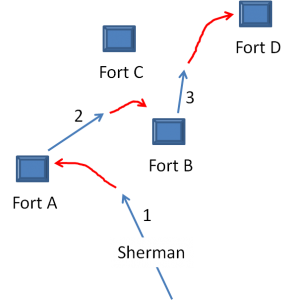Recently in the news, reported by the Fox Network and various newspapers, incl. my local Coloradoan: A North Carolina woman of the Wiccan faith locked horns with school district administrators. She attempted to convince them not to allow the distribution of Christian bibles at the school her daughter was attending.
The school district did so, anyway. How to deal with this? As it happens, the law gave the mother, Ginger Strivelli, just what she needed to devise a strategy that created an untenable dilemma for the administrators.
The law reads that the administration has two choices. 1) If they refuse the distribution of materials from any faith, they must refuse distribution of materials from all faiths, and 2) if they allow the distribution of materials from any faith, they must allow the distribution of materials from all faiths.
This allowed Ms. Strivelli to establish 2 alternative objectives for herself: either prevent the distribution of bibles, or distribute Wiccan materials at the school. She preferred that the schools not distribute the bibles, but either would be an acceptable outcome to her.
And neither would be an acceptable outcome to the school district. They would have to swallow one of the outcomes unacceptable to them, and she would walk away with an outcome that was acceptable to her. She’d put them on the horns of a dilemma. Damned if you do; damned if you don’t. Check one box.
Here’s what her strategy looked like:
The administration’s response was to stop the distribution of the Gideon bibles (while they “study” the school’s policies in relation to the law). Game over. Ginger 1, School Dist. 0.
Sherman
When thinking about dilemma-based adversarial strategies, General William Tecumseh Sherman comes to mind. No one exceeded Sherman in this kind of strategic thinking.
Here’s an example from Sherman’s Civil War playbook:
Sherman Creating Dilemmas
Sherman, with a substantial force, would threaten two Confederate forts, neither of which by themselves had the means to successfully resist him. He’d march in a way that he could readily attack either fort (blue arrow path 1 in diagram).
The Confederates, not knowing where he was going to attack and not wanting to throw away their men and resources, would consolidate the bulk of their men and material from one fort (A) to the other (B), to have a credible defense there. Sherman would then move toward and take essentially undefended Fort A. Thank you very much.
Now based at Fort A, he would then drive ambiguously on a path (2) generally toward Forts B or C. The Confederates, needing to solve the same puzzle as before, would have to choose between loosing Fort B or C. They concentrate their forces in Fort C, and Sherman easily takes Fort B. Thank you very much.
Now based at Fort B, Sherman makes a thrust (3) … well, you get the idea. Sherman was a master at strategies that give an opponent only two choices, both bad, and then exploiting whatever choice they made.
Saddling an opponent with a dilemma is an indirect strategy. Sherman, for example, didn’t even have to engage the enemy force in order to take the forts (now that’s indirect)! He took them just by arranging the situation. Nearly zero loss of his troops with this strategy – think about that. Similarly with Ginger Strivelli. She didn’t have to go to court and win a legal battle. She just had to walk into the school with a box full of scary Wiccan witchcraft books, and walk out with the termination of the school bible distribution project in her pocket. Objective accomplished. Thank you very much.
_________________________________
Readers are encouraged to add comments to this post.
And if you’d like to share or recommend the post, click on your preferred way in the left margin sidebar.
OK, I lied in the post before this one when I said that the next one would be about devising complex strategies. I couldn’t resist first responding to this dilemma strategy story in the news. But I promise to get back on track in the next post, and as I said before, the good news is that Devising Complex Strategies is much easier than you may think.
If you’re not currently being automatically notified when new posts are published, then please Follow Real Strategy (top of right hand column on this page), and indicate how you’d prefer to be notified.
For other posts of interest, look in the Smart Menu.
Ginger Strivelli image from Wild Hunt, a modern pagan blogsite authored by Jason Pitzl-Waters at http://www.patheos.com/blogs/wildhunt/tag/ginger-strivelli









What is that German term? Schadenfreude? Is it naughty to savor the moment as I learn about the strategy devised by Ginger Strivelli? — just enjoying what I would guess was a scathing rebuke to the school district.
[Translate]
These posts continue to be very entertaining, Bill. Thank you very much. Many of us get vicarious enjoyment from Ms. Strivelli scoring off the school administrators.
The strategy of saddling your “opponent” with two choices, either of which would be ok with you, is also a very effective technique in parenting. In fact, it works well in the classroom, too. “Would you like to turn off your phone, or would you like me to keep it for you?” “Would you like to finish that now, or would you prefer to finish it during lunch?”
While the choices offered by Ms. Strivelli and by Gen. Sherman worked to weaken their opponents, the choices offered in these parenting and classroom management examples work to empower the kids/students. While Strivelli and Sherman’s choices forced a dilema, the management examples force the kids/students to take control of their actions. Same technique, different choices, same outcome.
Very effective.
[Translate]
Sonja – Really excellent examples of using dilemmas in the teaching and parenting environments!
[Translate]
I’d like also to comment that I enjoy receiving these posts on Fridays. It’s a nice change of pace after the week and a nice segue into the weekend.
[Translate]
OK, is any one here interested in helping me develop a strategy for getting certain progressive outcomes in government in spite of all the money pouring in to buy officials and all of the obstructionism? Too complex?
[Translate]
Anna – I think any kind of outcome will be hard to get through Congress in spite of the money influence. It’s significant on both sides of the isle. It seems most Congressmen love it; it makes & keeps them wealthy, especially if they’re there long enough to chair key committees.
One major (prerequisite) objective could be to bring the D.C. money/influence system under control. Then you could have a better shot at legislation or policy outcomes you think important. But the big money players are powerful and entrenched. And that means that the strategy would have to be indirect, like Guerilla warfare. In his recent book, Republic Lost, Lawrence Lessig takes up the question of how to defeat the money/influence complex and offers 4 strategies for doing this. Maybe you’d find it worth plugging into.
[Translate]
I would seem that, if you’re going to strategize to defeat an adversary, you have to know pretty clearly what the adversary will do after being defeated. In the case of the school administrators they will probably just keep looking for more ways to sell Christianity and deprecate Wicca. In the end Christianity probably didn’t lose any adherents, but when people learned what the Wicca lady had done that probably just reinforced stereotypes of witches and solidified opposition to Wicca philosophy. I think she has won the battle but created a bigger barrier that will cause her to lose the war. Shows the dangers of defining the game too narrowly.
[Translate]
Interesting comment. In the posts just published today in this blog, a focus is on decomposition of strategies into their substrategies. It’s also possible to look in the other direction, recognizing that any strategy one is entertaining can be viewed as a substrategy of one or more other (higher level) strategies – and that’s the direction in which your comment takes us.
It’s good practice to look ahead, and to extend the Objectives Diagram (see current posts) to the right, to see if your current objective supports higher level objectives, as your comment would suggest. Many a time a lower level strategy undercuts a higher-level one (try Presidential election campaigns).
So supporting the higher level is a good thing, provided you know enough, care enough, or forecast well enough to do that. Sometimes it’s only feasible to plug in with one strategy, detach when it’s time, and then adapt with a newly informed strategy. In some cases the environment may have been evolving and the earlier higher level objective may have become obsolete (a common problem with grand strategies – being overtaken by events).
I’m not sure if Ms. Strivelli was following the star of a higher level strategy, or just trying to get the administrators to back off their distribution program. As for side-effects …
[Translate]
Great post! I seem to learn something every time I read these! Keep ’em coming. 🙂
[Translate]